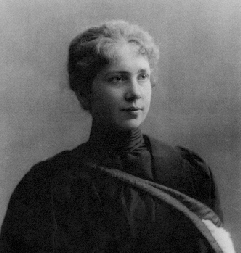Harriet Brooks – First Canadian Female Nuclear Physicist/Pioneer of Radioactivity Research
Harriet Brooks (1876-1933) was the first Canadian female nuclear physicist credited with significant contributions to Nuclear Physics. She contributed to the understanding of atomic recoil. She also discovered that thorium was emitting radioactive substances, specifically gas with molecular weight of 40–100 which was crucial for the understanding of the transmutation process.
- Harriet was born in Exeter, Ontario, on July 2, 1876 — one of nine children. Her father owned his own flour mill, which burned down so the family was forced to move out, finally settling in Montreal.
- Harriet Brooks entered McGill University in Montreal in 1894. She was an excellent student, but could not receive a scholarship since she was a woman. She graduated with first-class honors in mathematics and natural philosophy in 1898 and was awarded the Anne Molson Memorial prize for outstanding performance in mathematics.
- She was the first female graduate student in Canada, graduating with the thesis: “Damping Oscillations in the Discharge of a Leyden Jar.”
- After graduating she began working with Sir Ernest Rutherford. Harriet contributed to the determination of the atomic mass of radon, which had been discovered in 1900. Papers by Rutherford and Brooks in 1901 and 1902 were published in the Royal Society Transactions and in the Philosophical Magazine.
- Brooks won the prestigious Bryn Mawr European Fellowship as the first woman to study at the Cavendish Laboratory in UK. Unfortunately, her supervisor, J. Thomson, was preoccupied with his own research and ignored her progress, so she decided to go back to America.
- In 1906, she became engaged to a Columbia University physics professor, but she had to break the engagement since the college’s trustees argued that one could not be both a married woman and a successful academic.
- She also worked at the Curie Institute in Paris under the supervision of Marie Curie on the half-life of lead. Her contributions were considered valuable there.
- Eventually Brooks secured a position at the University of Manchester. In the letter of recommendation Rutherford wrote for Brooks’ application, he noted that “next to Mme Curie she is the most prominent woman physicist in the department of radioactivity. Miss Brooks is an original and careful worker with good experimental powers and I am confident that if appointed she would do most excellent research work in Physics”.
- In 1907, at the age of 31, Brooks married Frank Pitcher, a wealthy engineer and a former McGill physics instructor and settled in Montreal. They had three children, two of whom tragically died in their teens. Brooks decided to terminate her physics career for unknown reasons, giving room for speculation that the “provinciality and social convention” turned her away from physics.
- She died at the age of 56 on April 17, 1933, in Montreal. Her death, identified at the time as ‘blood disorder,’ was probably a leukemia caused by radiation exposure.

https://www.facebook.com/USWomeninNuclear/posts/821105340060740?ref=embed_post # 16 installment of Women in Nuclear